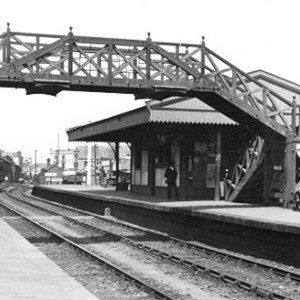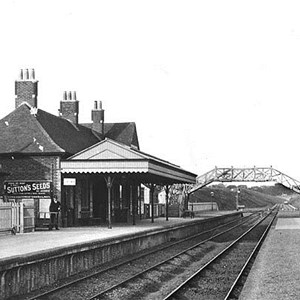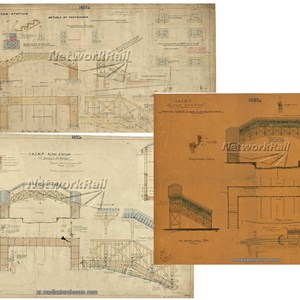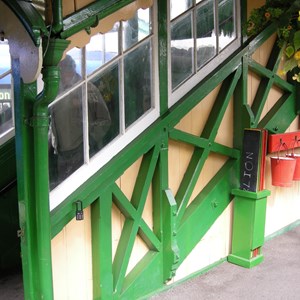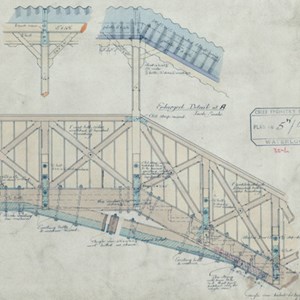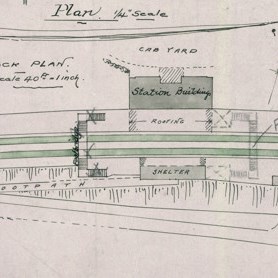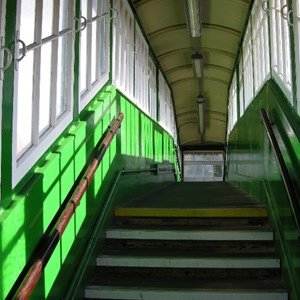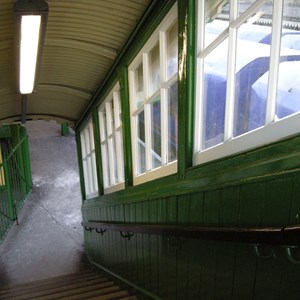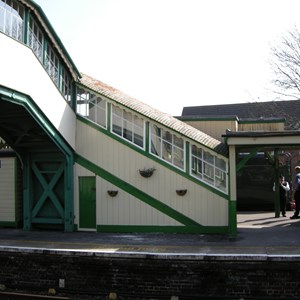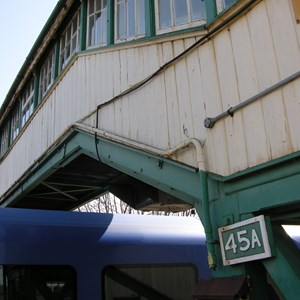Footbridge History
A Footbridge for Alton Station
The 1852 terminus station only had one platform, so there was no need for passengers to cross the tracks. However, when the station was rebuilt in 1865 with two platforms, passengers were expected to cross the tracks on the level or approach by a path from the south side of the embankment leading from paper Mill Lane. Apparently a foot subway was proposed in 1884 when the ownership of the railway was transferred to the London and South Western Railway (LSWR), but was rejected, so it wasn't until 1892 that an open wooden footbridge was provided.
We can't find a picture of this early form of the bridge at Alton, but above you can see photos of similar LSWR examples. On the left is the footbridge at Wadebridge, part of the 'withered arm' LSWR railway to Padstow in Cornwall. The next three pictured were on the Meon Valley Railway (left to right): West Meon, Droxford and Wickham. We also know that the earlier design of this bridge, with corner trusses, was installed at West Clandon, Oxshott and Andover Town stations.
The footbridge today is covered, perhaps not elegantly, but it was this action that led to the preservation of the wood. The reason it was covered leads to another interesting story. The "ladies of Alton" petitioned the London and South Western Railway (LSWR) to have it covered, and they succeeded. Recent research has led to so much information on this topic that we have created a page devoted to this: The Ladies of Alton. Suffice to day that we have them to thank both for providing a covered way for people to get from platform to platform, and also in preserving the fabric of the bridge.
Our research also reveals that these 'ladies of Alton' were in fact the local group of the sufferance movement, and they took part in a national petition in 1894 asking for votes for women. This date ties the covering of the footbridge in with the wider social upheaval going on in the period. We have often reflected that it is a pity that Jane Austen was not alive to have walked over the footbridge, but the suffrage connection continues the story of women in the male-dominated society of the day.
What we can learn from the plans
Fortunately for us, Network Rail hold the plans for all three stages of the bridge's construction (low resolution versions shown on left) in their archives and you can buy prints or high-resolution digital copies from them using this link:
http://nr.mediastorehouse.com/alton-station-footbridge/photo/114001.html
What the plans reveal is that the original design of the struts are different to what we see today. Although we first thought that the structure of the bridge had been altered, we are now fairly certain that the plans were never updated to reflect the later design of footbridge. The earlier design braced the top level of the bridge with corner trusses, but these probably interfered with what is known as the loading gauge (the clearance required for all structures that trains pass near). The later design, seen in photos at the top of this page of the footbridges on the Meon Valley Line and at Wadebridge in Cornwall, used a trapezoid frame structure (known as Howe truss) that braced the structure within the height of the handrail.
What we do know is that the after the alterations had been made in 1892 and 94, the boarding infill was on the inside of the cross-struts, as seen on platform 3 (Mid-Hants Railway) at Alton station. The addition of the roof required the addition of some rather nice shaped wooden braces at the lower edge of the framing and again this is seen on the side facing platform 3. The rest of the footbridge has external matchboarding and the braces have gone. We think this might have been done between the wars by Southern Railway, probably to stop the weather from rotting the angled struts.
There are other interesting things we can learn from the plans. The 1892 and 1896 plans both show the footbridge in a different location on the site plan (see image above, on right-hand side). As it happens, there is an Ordnance Survey plan of the station dated 1896 and it shows the bridge in its current location, so it rather suggests that a decision was taken in 1892 to position the bridge in a different place. In any case, if the bridge had been located where it was shown on the plans, the creation of platform 3 for the Meon Valley Railway in 1903 would have necessitated the relocation of the footbridge because it would have been too close to the new platform face.
The 1892 plans tell us in great detail about the bridge construction, including the fact that is almost entirely bolted together, with very few tenon joints. It also shows that each wooden leg was bolted into a specially-made cast iron 'shoe' that was bolted onto a concrete foundation. Although they are not visible, similar metal shoes can be seen at Eridge station where there is a similar vintage lean-to footbridge. The 1896 plans tell us that the windows were priced at £90. According to the Bank of England's inflation calculator, this would be £10,987 at 2016 prices.
Even the smallest details on the plans have something to add to the story. The 1892 plans have a hand-written note at the top saying, "Clinker footbridge similar to this erected at Clandon 1894." This note led us to find photos of the Clandon footbridge and also at Andover Town station, giving us photos of the bridge type with the angled corner struts, as per the plans. The other slightly interesting fact is that all the footbridge plans have the number 1490A at the top, indicating that this was the original bridge number, since changed to 45A. We suspect that this change was made in 1923 when the London and South Western Railway was absorbed into the Southern Railway when 'the big four' railway companies were formed by government.
Aside from the plans, we have also been lucky enough to be given special access to see inside the footbridge. This was done in preparation for what became the January 2017 Ebbutt Report. See the Restoring 1892 Footbridge page for more details and to download the report. The inspection revealed that the timbers were not painted when the bridge was constructed, so if the sides were boarded over with match boards in say 1932, then the bridge lasted 40 years in bare wood. It may well have received coats of creosote or teak oil during this period, but that's still good for a timber structure.
The Bridge Today
The bridge was removed in March 2020 and we later had it dismantled into its component pieces in January 2022. The pictures above show the bridge not long before it's removal in 2020. Whilst the internal match-boarding had gone from the centre section of the bridge, but they survived on the flight of stairs on platforms 2 & 3. Some of the balustrade cross bracing had also survived, hidden behind the panelling. The bridge served Altonians for well over a century, but the modern requirement for access for all led to a new bridge being built further along the platform. Once this was opened, it turned the historic or heritage footbridge into an extra burden for Network Rail and South Western Railway. In the end it came down to who is going to pay to make the bridge safe and to restore it for posterity, and that's why there were protracted negotiations to save the bridge. Whilst we lost the battle to keep the bridge in the same location, we now hope to restore it and install it over the Watercress Line. To read more see: Restoring 1892 Footbridge.
HISTORY Page Index
Introduction: The Railway Comes to Alton
Footbridge History
The Ladies of Alton
Mid-Hants Railway
Basingstoke & Alton Light Railway
Meon Valley Railway
Longmoor Military Railway
Bentley & Bordon Light Railway
Click on these links, or use the drop-down menu above to navigate between the pages.
